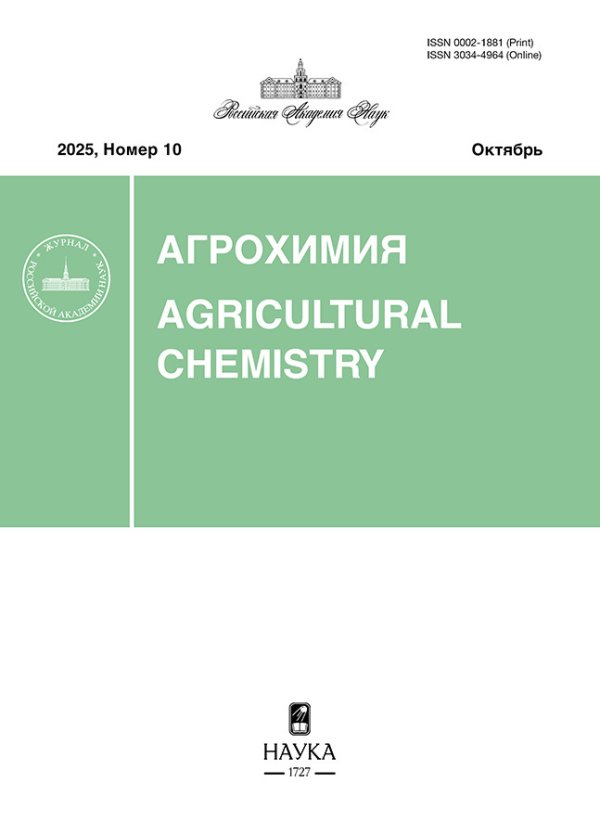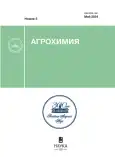Fertility and ecotoxicological condition of light gray forest soils of the Ivanovo region
- Authors: Utkin А.А.1, Noda I.B.2
-
Affiliations:
- Russian State Agrarian Universite – K. A. Timiryazev Moscow Agricultural Academy
- Agrochemical Service Station “Ivanovskaya”
- Issue: No 5 (2024)
- Pages: 71-78
- Section: Ecotoxicology
- URL: https://rjsvd.com/0002-1881/article/view/647212
- DOI: https://doi.org/10.31857/S0002188124050096
- EDN: https://elibrary.ru/CYNYZK
- ID: 647212
Cite item
Abstract
The results of long-term monitoring of light gray forest soil for agricultural purposes in the Ivanovo region are presented, which was carried out to establish the level of fertility according to the main agrochemical indicators, the content of mobile forms of trace elements and sulfur, the ecotoxicological state according to the content of gross and mobile forms of heavy metals, arsenic, caesium-137 and strontium-90. The average values of the indicators, their levels of change and trends in changes in the metabolic and hydrolytic acidity of the soil, availability of organic matter, mobile forms of nitrogen, phosphorus, potassium, exchangeable calcium, magnesium and other bases, mobile forms of boron, copper, zinc, molybdenum, cobalt, manganese and sulfur have been established. According to the content of trace elements in the soil, the needs for the use of micronutrients are determined. Changes, concentrations and trends in the mobile forms of cadmium, lead, copper, zinc, nickel, chromium, mercury and arsenic in the soil have been determined. The study established background values, changes and trends in the specific activities of caesium-137 and strontium-90, the density of their contamination of the soil of the site and the power of the exposure dose of gamma radiation. According to the Pearson–Spearman correlation coefficients, the peculiarities of the influence of the content of organic matter, the level of acidity and the capacity of cation exchange on the content of mobile forms of trace elements, sulfur, gross and mobile forms of metals and radionuclides were established.
Full Text
About the authors
А. А. Utkin
Russian State Agrarian Universite – K. A. Timiryazev Moscow Agricultural Academy
Author for correspondence.
Email: aleut@inbox.ru
Russian Federation, 127434, Moscow, ul. Timiryazevskaya 49
I. B. Noda
Agrochemical Service Station “Ivanovskaya”
Email: aleut@inbox.ru
Russian Federation, 153506, d. Bogorodskoye, ul. Centralnaya 8
References
- Шафран С.А. Динамика плодородия почв Нечерноземной зоны // Агрохимия. 2016. № 8. С. 3–10.
- Кирюшин В.И. Управление плодородием почв и продуктивностью агроценозов в адаптивно-ландшафтных системах земледелия // Почвоведение. 2019. № 9. С. 1130–1139.
- Уткин А.А., Аканова Н.И., Нода И.Б. Динамика содержания и распределения микроэлементов в дерново-подзолистых почвах и растениях агроценозов // Агрохимия. 2023. № 8. С. 3–15. https://doi.org/10.31857/S0002188123080100
- Уткин А.А., Мазиров М.А. Эффективное применение органических удобрений в сельскохозяйственном производстве: уч. пособ. Иваново: ИГСХА, 2022. 80 с.
- Агроэкологическая оценка земель, проектирование адаптивно-ландшафтных систем земледелия и агротехнологий. Метод. рук-во / Под ред. В.И. Кирюшина, А.Л. Иванова. М.: Росинформагротех, 2005. 784 с.
- Фирсов С.А., Баранова Т.Л., Фирсов С.С. Экологический мониторинг безопасности почв по содержанию тяжелых металлов // Агрохим. вестн. 2014. № 3. С. 5–7.
- Уткин А.А., Лукьянов С.Н. Плодородие и экотоксикологическое состояние реперных участков серых лесных почв Владимирской области // Агрохимия. 2022. № 3. С. 12–21. https://doi.org/10.31857/S0002188122030139
- Уткин А.А. Плодородие и экотоксикологическое состояние реперных участков дерново-подзолистых суглинистых почв Владимирской области // Агрохимия. 2022. № 6. С. 3–13. https://doi.org/10.31857/S0002188122060126
- Уткин А.А. Мониторинг плодородия и экотоксикологического состояния реперных участков дерново-подзолистых почв Ивановской области // Агрохимия. 2023. № 4. С. 19–31. https://doi.org/10.31857/S0002188123040130
- Гордеев А.В., Клещенко А.Д., Черняков Б.А., Сиротенко О.Д. Биоклиматический потенциал России: теория и практика. М.: Тов-во научн. изд-й КМК, 2006. 509 с.
- Методические указания по определению тяжелых металлов в почвах сельхозугодий и продукции растениеводства. М.: ЦИНАО, 1992. 61 с.
- Руководящий документ. Массовая доля кислоторастворимых форм металлов в пробах почв, грунтов и донных отложений. Методика измерений методом атомно-абсорбционной спектрометрии. РД 52.18.191–2018. Обнинск: Росгидромет, 2019. 36 с.
- Руководящий документ. Методические указания. Методика выполнения измерений массовой доли подвижных форм металлов (меди, свинца, цинка, никеля, кадмия, кобальта, хрома, марганца) в пробах почвы атомно-абсорбционным анализом. РД 52.18.289–90. М.: Гос. комитет СССР по гидрометеорологии, 1990. 36 с.
- Методические указания по определению мышьяка в почвах фотометрическим методом. М.: ЦИНАО, 1993. 13 с.
- Критерии оценки экологической обстановки территории для выявления зон чрезвычайной экологической ситуации и зон экологического бедствия / Под ред. Н.Г. Рыбальского. М.: Минприроды России, 1992.
- Методические указания по проведению комплексного мониторинга плодородия почв земель сельскохозяйственного назначения. М.: Росинформагротех, 2003. 240 с.
- Гамзиков Г.П. Агрохимия азота в агроценозах. Новосибирск: РАСХН, СО, 2013. 790 с.
- Ильин В.Б., Сысо А.И. Микроэлементы и тяжелые металлы в почвах и растениях Новосибирской области. Новосибирск: Изд-во СО РАН, 2001. 229 с.
- Пейве Я.В. Агрохимия и биохимия микроэлементов. Избр. тр. М.: 1980. 430 с.
- Каталымов М.В. Микроэлементы и микроудобрения. М.: Химия, 1965. 330 с.
- Ягодин Б.А., Жуков Ю.П., Кобзаренко В.И. Агрохимия / Под ред. Б.А. Ягодина. М.: Колос, 2002. 584 с.
- Бакирова В.Г., Минибаев В.Г., Тюменева Р.Б. Содержание различных форм марганца, кобальта и молибдена в дерново-подзолистых и серых лесных оподзоленных почвах Марийской и Чувашской АССР // Научные основы повышения плодородия почв. Саранск, 1983. С. 114–118.
- Панасин В.И. Микроэлементы и урожай. Калининград: Калининград. кн. изд-во, 2000. 276 с.
- Битюцкий Н.П. Микроэлементы и растение. Уч. пособ. СПб.: Изд-во СПбГУ, 1999. 232 с.
- Аристархов А.Н. Сера в агроэкосистемах России: мониторинг содержания в почвах и эффективность ее применения // Международ. сел.-хоз. журн. 2016. № 5. С. 39–47.
- Овчаренко М.М. Тяжелые металлы в системе почва–растение–удобрение / Под ред. М.М. Овчаренко. М.: Пролетарский светоч, 1997. 290 с.
- Шихова Л.Н., Егошина Т.Л. Тяжелые металлы в почвах и растениях таежной зоны Северо-Востока европейской России. Киров: Зональный НИИСХ Северо-Востока, 2004. 264 с.
- Зырин Н.Г., Садовникова Л.К. Химия тяжелых металлов, мышьяка и молибдена в почвах. М.: Изд-во МГУ, 1985. 209 с.
- Кабата Пендиас А., Пендиас Х. Микроэлементы в почвах и растениях. М.: Мир, 1989. 439 с.
- Ковда В.А. Биогеохимия почвенного покрова. М.: Наука, 1985. 263 с.
- Добровольский В.В. Основы биогеохимии. М.: Высш. шк., 1998. 411 с.
- Чернова О.В., Бекецкая О.В. Допустимые и фоновые концентрации загрязняющих веществ в экологическом нормировании (тяжелые металлы и другие химические элементы) // Почвоведение. 2011. № 9. С. 1102–1113.
- Радиационная обстановка на территории СССР в 1990 г. / Под ред. К.П. Махонько. Обнинск: НПО “Тайфун”, 1991.
- Уткин А.А., Аканова Н.И., Нода И.Б. Мониторинг 137Cs,90Sr и 40K в дерново-подзолистых почвах и растениях реперных участков Ивановской области // Агрохимия. 2023. № 7. С. 75–85. https://doi.org/10.31857/S0002188123070116
- Орлов П.М., Аканова Н.И. Радиоактивность почв сельскохозяйственных угодий Сибири в условиях различной интенсивности химизации сельскохозяйственного производства // Агрохимия. 2019. № 9. С. 91–96. https://doi.org/10.1134/S0002188119090102
Supplementary files











